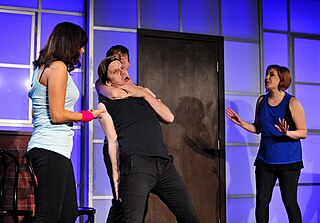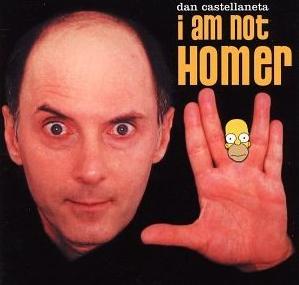
Sketch comedy comprises a series of short, amusing scenes or vignettes, called "sketches", commonly between one and ten minutes long, performed by a group of comic actors or comedians. The form developed and became popular in vaudeville, and is used widely in variety shows, comedy talk shows, and some sitcoms and children's television series. The sketches may be improvised live by the performers, developed through improvisation before public performance, or scripted and rehearsed in advance like a play. Sketch comedians routinely differentiate their work from a "skit", maintaining that a skit is a (single) dramatized joke while a sketch is a comedic exploration of a concept, character, or situation. Sketch comedy is a genre within American television that includes a multitude of schemes and identities.

William Alexander "Bud" Abbott was an American comedian, actor and producer. He was best known as the straight man half of the comedy duo Abbott and Costello.

Louis Francis Cristillo, better known as Lou Costello, was an American comedian, actor and producer. He was best known for his double act with Bud Abbott and their routine "Who's on First?".

Abbott and Costello were an American comedy duo composed of comedians Bud Abbott and Lou Costello, whose work in radio, film, and television made them the most popular comedy team of the 1940s and 1950s, and the highest-paid entertainers in the world during the Second World War. Their patter routine "Who's on First?" is considered one of the greatest comedy routines of all time, a version of which appears in their 1945 film The Naughty Nineties.

Wayne and Shuster were a Canadian comedy duo formed by Johnny Wayne and Frank Shuster. They were active professionally from the early 1940s until the late 1980s, first as a live act, then on radio, then as part of The Army Show that entertained troops in Europe during World War II, and then on both Canadian and American television.

Smith and Dale were a famous American vaudeville comedy duo. They consisted of Joe Smith and Charlie Dale, who both grew up in the Lower East Side of New York City at the end of the 19th century. Beginning in their adolescence, their career spanned the majority of their lives, with the two performing together continuously for more than seventy years.
What or WHAT may refer to:

Joe Besser was an American actor, comedian, and musician, known for his impish humor and wimpy characters. He is best known for his brief stint as a member of The Three Stooges in movie short subjects of 1957–59. He is also remembered for his television roles: Stinky, the bratty man-child on The Abbott and Costello Show, and Jillson, the maintenance man on The Joey Bishop Show.
"Slowly I Turned" is a popular vaudeville sketch wherein a character is relating a story and is triggered into violent outbursts when the listener inadvertently utters a triggering word or phrase. Versions have also been performed in movies and on television. Comedians Harry Steppe, Joey Faye, and Samuel Goldman each laid claim to this routine, also referred to as "The Stranger with a Kind Face" by clowns, "Niagara Falls" by fans of The Three Stooges and Abbott and Costello, "Martha" by fans of I Love Lucy, "Pokomoko", and "Bagel Street".

Buck Privates is a 1941 American musical military comedy film directed by Arthur Lubin that turned Bud Abbott and Lou Costello into bona fide movie stars. It was the first service comedy based on the peacetime draft of 1940. The comedy team made two more service comedies before the United States entered the war. A sequel to this movie, Buck Privates Come Home, was released in 1947. Buck Privates is one of three Abbott and Costello films featuring The Andrews Sisters, who were also under contract to Universal Pictures at the time.

The Naughty Nineties is a 1945 American film starring the comedy team of Abbott and Costello. The film is noteworthy for containing a filmed version of the duo's famous "Who's on First?" routine. This version is shown at the National Baseball Hall of Fame and Museum in Cooperstown, New York.

Reginald Lucien Frank Roger Watts is an American comedian, actor, beatboxer, and musician. His improvised musical sets are created using only his voice, a keyboard, and a looping machine. Watts refers to himself as a "disinformationist" who aims to disorient his audience in a comedic fashion. He was the regular house musician on the spoof IFC talk show Comedy Bang! Bang!. From 2015 to 2023, Watts led the house band for The Late Late Show with James Corden.

In the Navy is a 1941 film starring the comedy team of Abbott and Costello. It was the second service comedy based on the peacetime draft of 1940. The comedy team appeared in two other service comedies in 1941, before the United States entered the war: Buck Privates released in January and Keep 'Em Flying released in November.

Hold That Ghost is a 1941 horror comedy film starring the comedy team of Abbott and Costello and featuring Joan Davis, Evelyn Ankers and Richard Carlson.

Who Done It? is a 1942 American comedy-mystery film directed by Erle C. Kenton and starring Bud Abbott and Lou Costello. It is noteworthy as their first feature that contains no musical numbers.

Lost in a Harem is a 1944 American comedy film directed by Charles Reisner and starring the team of Abbott and Costello alongside Marilyn Maxwell.

In Society is a 1944 film starring the comedy team of Abbott and Costello. It was the first of five Abbott and Costello films to be directed by Jean Yarbrough. It was re-released in 1953.

Mexican Hayride is a 1948 film starring the comedy team of Abbott and Costello. The film is based on Cole Porter's Broadway musical Mexican Hayride starring Bobby Clark. No songs from the stage musical were used in the film.

I Am Not Homer is a 2002 comedy album by actor and comedian Dan Castellaneta, with additional input by his wife Deb Lacusta. The album is a collection of comedy sketches written and performed by Castellaneta and Lacusta, and was the follow-up to Castellaneta's previous all-music album Two Lips. The title of the album is a reference to Leonard Nimoy's first autobiography, I Am Not Spock, and a majority of the sketches were material that the pair had used before in their careers, but no longer performed live.

The Abbott and Costello Show is a comedy program from the era of old-time radio in the United States. It was broadcast first on NBC and later on ABC, beginning on July 3, 1940 and ending on June 9, 1949.


















